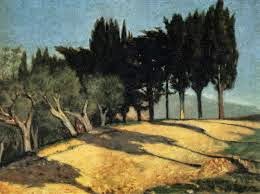Several different paths have converged over the past few weeks to bring me to the same destination: the Italian school of painters called "The Macchiaioli". They painted in Tuscany in the second half of the 19th century. Like the French Impressionists, they broke with tradition
to paint outdoors, in order to observe directly the natural light and color. The Macchiaioli are best known for their small, sketch-like paintings. In fact, that's the origin of their nickname--a "macchia" being a small sketch composed of blocks of color.
How have I missed these wonderful works all my life?? It appears that museums and art historians have put their 19th century focus on the French Impressionists, and the Macchiaioli are scarcely represented in museums outside of Italy.
Last year, the Musee d'Orsay in Paris mounted an exhibition featuring these works. The title was "The Macchiaioli. Italian Impressionists?" In a review of that exhibit, Linda Y. Peng wrote that "it was the light, the supreme pervasive Tuscan sun, the myriad effects of it and the sublime truth of nature and humanity that these Italian painters caught and appropriated." They were ahead of the French Impressionists by years in adopting the practice of painting outdoors--or all'aperto in Italian.
I love the simple shapes of color in these paintings. So modern and uncluttered! I was not surprised to read in an interview with Frank Hobbs that he is inspired by the Macchiaioli. I have admired Hobbs' work since I first encountered it years ago, and now that my eye is more educated, I can see the influence of the Macchiaioli in his paintings. They seem to share the same sensibility for working from observation and for painting familiar, everyday realities. To me, Hobbs' steel cylinders (below) recall Abbati's Cloister of Santa Croce (above).
Even the choice to paint a mundane scene, rather than a grand vista or architectural marvel, denotes a kinship between the painters. Abbati's painting shows a lowly worker resting by the construction rubble during renovation of the grand cathedral Hobbs' painting depicts abandoned industrial materials. Both painters show a perception of form and color relationships that give their paintings true presence.
I am excited about exploring the Macchiaioli in greater depth. Stay tuned for more about them, and about their influence on those who have come after them.
to paint outdoors, in order to observe directly the natural light and color. The Macchiaioli are best known for their small, sketch-like paintings. In fact, that's the origin of their nickname--a "macchia" being a small sketch composed of blocks of color.
 |
| Rafaello Sernesi (date and title unknown) |
Last year, the Musee d'Orsay in Paris mounted an exhibition featuring these works. The title was "The Macchiaioli. Italian Impressionists?" In a review of that exhibit, Linda Y. Peng wrote that "it was the light, the supreme pervasive Tuscan sun, the myriad effects of it and the sublime truth of nature and humanity that these Italian painters caught and appropriated." They were ahead of the French Impressionists by years in adopting the practice of painting outdoors--or all'aperto in Italian.
 |
| "Cloister of the Church of Santa Croce in Florence" Guiseppe Abbati, 1861-62 |
Even the choice to paint a mundane scene, rather than a grand vista or architectural marvel, denotes a kinship between the painters. Abbati's painting shows a lowly worker resting by the construction rubble during renovation of the grand cathedral Hobbs' painting depicts abandoned industrial materials. Both painters show a perception of form and color relationships that give their paintings true presence.
 |
| "Country Road with Cypresses" Guiseppe Abbati, 1860 |


No comments:
Post a Comment